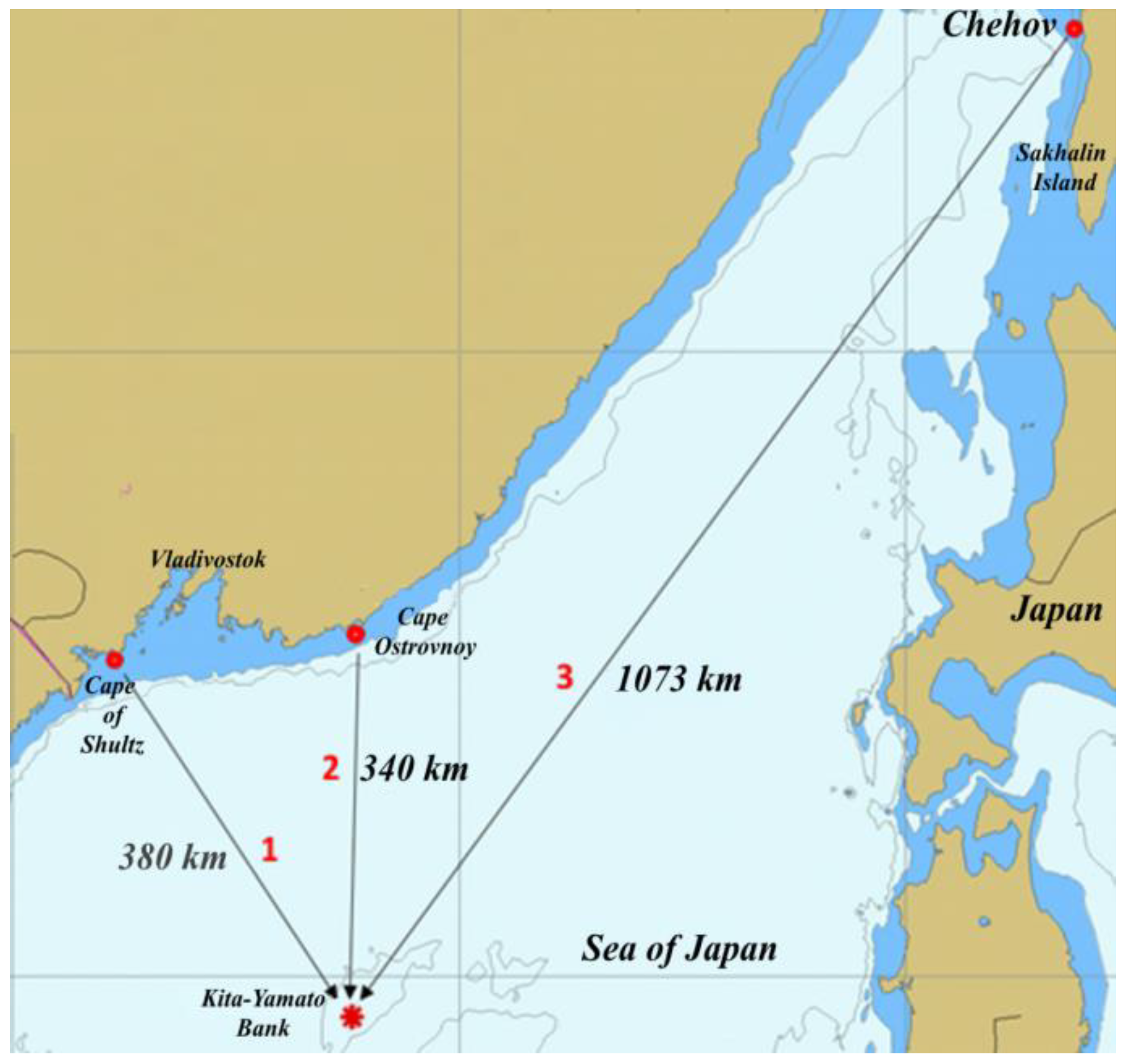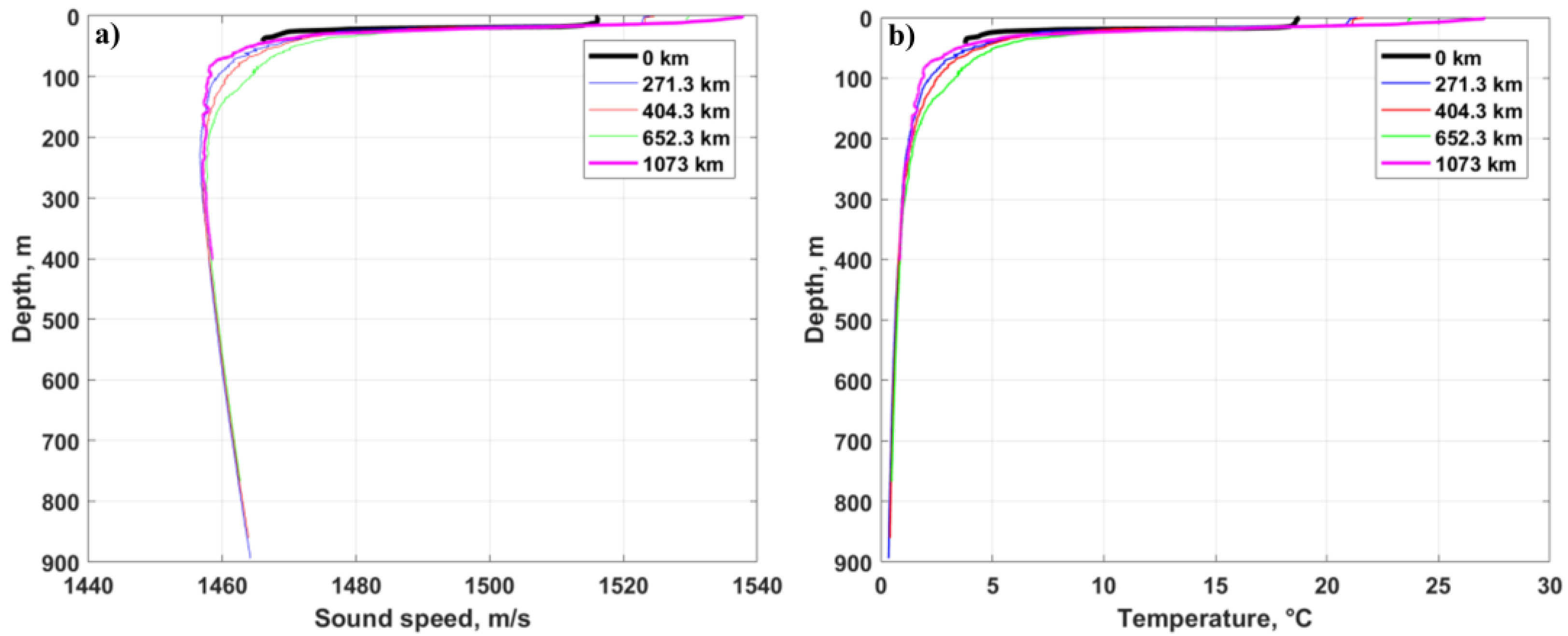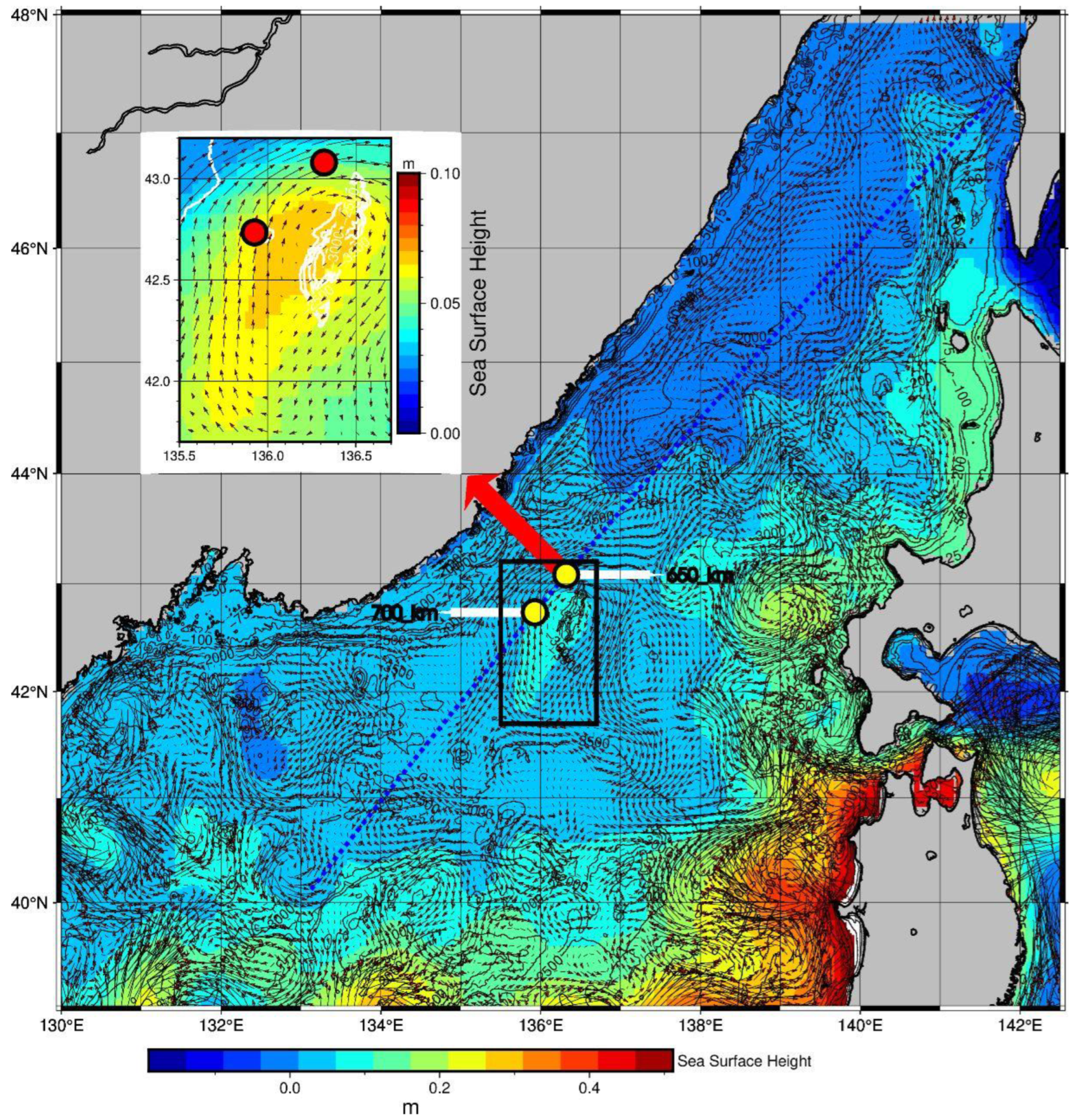Pilot Acoustic Tomography Experiment in the Sea of Japan at 1073 km Distance
Abstract
1. Introduction
- development and approbation of the appearance of the measuring system for the study and control of temperature regimes in the Sea of Japan by the method of acoustic thermometry;
- experimental studies of the features of the formation and interaction of hydroacoustic and hydrological fields on a long (over 1000 km) track when crossing a vortex system;
- carrying out a numerical simulation of the processes of formation and interaction of hydroacoustic and hydrological fields along an extended acoustic path in the northeastern part of the Sea of Japan using the NEMO (Nucleus for European Modelling of the Ocean) ocean hydrodynamic circulation model and the RAY computer program.
2. Means and Methods
2.1. Method and Technical Implementation of Temperature Control in the Sea of Japan
2.2. Hydrological Situation in the Study Area
3. Results
3.1. Acoustic Thermometry Results
- L—distance between emitting and receiving points at sea level, m;
- 4 × 107—mean circumference of the earth at sea level, m;
- d—USC axis depth, m.

- L—acoustic track length, m;
- τ—travel time, s;
- ∆τ—M-sequence symbol duration, s.
3.2. Numerical Simulation Results
4. Conclusions
Author Contributions
Funding
Institutional Review Board Statement
Informed Consent Statement
Data Availability Statement
Acknowledgments
Conflicts of Interest
References
- Munk, W.; Wunsh, C. Ocean acoustic tomography: A scheme for large scale. Deep-Sea Res. 1979, 26, 123–161. [Google Scholar] [CrossRef]
- Dushaw, B.D.; Worcester, P.F.; Munk, W.H.; Spindel, R.C.; Mercer, J.A.; Howe, B.M.; Metzger, K., Jr.; Birdsall, T.G.; Andrew, R.K.; Dzieciuch, M.A.; et al. A decade of acoustic thermometry in the North Pacific Ocean. J. Geophys. Res. 2009, 114, 1–24. [Google Scholar] [CrossRef]
- Mikhalevsky, P.N.; Gavrilov, A.N.; Baggeroer, A.B. The Transartic acoustic propagation experiment and climate monitoring in the Artic. IEEE J. Ocean. Eng. 1999, 24, 183–201. [Google Scholar] [CrossRef]
- Send, U.; Schott, F.; Gaillard, F.; Desaubies, Y. Observation of a deep convection regime with acoustic tomography. J. Geophys. Res. Oceans. 1995, 100, 6927–6941. [Google Scholar] [CrossRef]
- Send, U.; Krahmann, G.; Mauuary, D.; Desaubies, Y.; Gaillard, F.; Terre, T.; Papadakis, J.; Taroudakis, M.; Skarsoulis, E.; Millot, C. Acoustic observations of heat content across the Mediterranean Sea. Nature 1997, 385, 615–617. [Google Scholar] [CrossRef]
- Worcester, P.F.; Cornuelle, B.D.; Dzieciuch, M.A.; Munk, W.H.; Howe, B.M.; Mercer, J.A.; Baggeroer, A.B. A test of basin-scale acoustic thermometry using a large- aperture vertical array at 3250-km range in the eastern North Pacific Ocean. J. Acoust. Soc. Am. 1999, 105, 3185–3201. [Google Scholar] [CrossRef]
- Munk, W.H.; Spiesberger, J.L.; Metzger, K.A.; Forbes, M.G. Global ocean warming: An acoustic measure? J. Phys. Oceanogr. 1989, 19, 1765–1778. [Google Scholar] [CrossRef]
- Spiesberger, J.L. Basin-scale tomography: A new tool for studying weather and climate. J. Geophys. Res. 1991, 96, 4869–4889. [Google Scholar] [CrossRef]
- Ko, D.S.; De Ferrari, H.A.; Malanette-Rizzoli, P. Acoustic tomography in the Florida Strait: Temperature, Current and Vorticity Measurements. J. Geoph. Res. 1989, 94, 6197–6211. [Google Scholar] [CrossRef]
- Baggeroer, A.B.; Birdsall, T.G.; Clark, C.; Colosi, J.A.; Cornuelle, B.D.; Costa, D.; Dushaw, B.D.; Dzieciuch, M.; Forbes, A.M.G.; Hill, C.; et al. Ocean climate change: Comparison of acoustic tomography, satellite altimetry, and modeling. Science 1998, 281, 1327–1332. [Google Scholar]
- Howe, B.M.; Anderson, S.G.; Baggeroer, A.B.; Colosi, J.A.; Hardy, K.R.; Horwitt, D.; Karig, F.W.; Leach, S.; Mercer, J.A.; Metzger, K.; et al. Instrumentation for the Acoustic Thermometry of Ocean Climate (ATOC) prototype Pacific Ocean network. In Proceedings of the ‘Challenges of Our Changing Global Environment’. Conference Proceedings. OCEANS’95 MTS/IEEE, San Diego, CA, USA, 9–12 October 1995; pp. 1483–1500. [Google Scholar]
- Morgunov, Y.N.; Bezotvetnykh, V.V.; Burenin, A.V.; Voitenko, E.A. Study of how hydrological conditions affect the propagation of pseudorandom signals from the shelf in deep water. Acoust. Phys. 2016, 62, 350–356. [Google Scholar] [CrossRef]
- Akulichev, V.A.; Kamenev, S.I.; Morgunov, Y.N. Application of complex acoustic signals in communication systems and navigation of submersible units. Dokl. Earth Sci. 2009, 427, 837–839. [Google Scholar] [CrossRef]
- Akulichev, V.A.; Bezotvetnykh, V.V.; Burenin, A.V.; Voitenko, E.A.; Morgunov, Y.N. Experimental evaluation of the influence of the vertical sound velocity profile at the source site in shallow water on the formation of the pulse response characteristics in the deep sea. Acoust. Phys. 2010, 56, 47–48. [Google Scholar] [CrossRef]
- Morgunov, Y.N.; Golov, A.A.; Burenin, A.V.; Petrov, P.S. Studies of spatiotemporal structure of the acoustic field formed in deep water by a broadband pulsed signal source on the shelf of the Sea of Japan. Acoust. Phys. 2019, 65, 537–544. [Google Scholar] [CrossRef]
- Tappert, F.D.; Spiesberger, J.L.; Wolfson, M.A. Study of a novel range-dependent propagation effect with application to the axial injection of signals from the Kaneohe source. J. Acoust. Soc. Am. 2002, 111, 757. [Google Scholar] [CrossRef]
- Petrov, P.S.; Golov, A.A.; Bezotvetnykh, V.V.; Burenin, A.V.; Kozitskiy, S.B.; Sorokin, M.A.; Morgunov, Y.N. Experimental and theoretical study on arrival times and effective velocities in the case of long-range propagation of acoustical pulses along the shelf edge in a shallow sea. Acoust. Phys. 2020, 66, 21–32. [Google Scholar] [CrossRef]
- Dolgikh, G.; Morgunov, Y.; Burenin, A.; Bezotvetnykh, V.; Luchin, V.; Golov, A.; Tagiltsev, A. Methodology for the Practical Implementation of Monitoring Temperature Conditions over Vast Sea Areas Using Acoustic Thermometry. J. Mar. Sci. Eng. 2023, 11, 137. [Google Scholar] [CrossRef]
- Chen, C.-T.; Millero, F.J. Speed of sound in seawater at high pressures. J. Acoust. Soc. Am. 1977, 62, 1129–1135. [Google Scholar] [CrossRef]
- Charles, F.F. Karney. Algorithms for geodesics. J. Geod. 2013, 87, 43–55. [Google Scholar] [CrossRef]
- Kaneko, A.; Zhu, X.H.; Lin, J. Coastal Acoustic Tomography; Elsevier: Amsterdam, The Netherlands, 2020; pp. 1–362. [Google Scholar] [CrossRef]
- Bowlin, J.B.; Spiesberger, J.L.; Duda, T.F.; Freitag, L.E. Ocean Acoustical Ray-Tracing Software RAY; Woods Hole Oceanographic Technical Report; WHOI-93-10; Woods Hole Oceanographic Institution: Woods Hole, MA, USA, 1992; p. 49. [Google Scholar]
- Sorokin, M.A.; Petrov, P.S.; Kaplunenko, D.D.; Golov, A.A.; Morgunov, Y.N. To the issue of theoretical and experimental estimates of the group velocity of the acoustic signal modal components on long tracks using ocean circulation models. Underw. Investig. Robot. 2022, 2, 54–64. [Google Scholar] [CrossRef]
- Morgunov, Y.N.; Bezotvetnykh, V.V.; Golov, A.A.; Burenin, A.V.; Lebedev, M.S.; Petrov, P.S. Experimental study of the impulse response function variability of underwater sound channel in the Sea of Japan using pseudorandom sequences and its application to long-range acoustic navigation. Acoust. Phys. 2021, 67, 287–292. [Google Scholar] [CrossRef]








| No | Distance(km) | Minimum of the Speed of Sound (m/s) | Depth (m) |
|---|---|---|---|
| 1 | 0 | 1466.025 | 41.4 |
| 2 | 271.3 | 1456.678 | 228.5 |
| 3 | 404.3 | 1457.067 | 272.4 |
| 4 | 652.5 | 1457.567 | 317.5 |
| 5 | 1073 | 1457.0756 | 242.9 |
Disclaimer/Publisher’s Note: The statements, opinions and data contained in all publications are solely those of the individual author(s) and contributor(s) and not of MDPI and/or the editor(s). MDPI and/or the editor(s) disclaim responsibility for any injury to people or property resulting from any ideas, methods, instructions or products referred to in the content. |
© 2023 by the authors. Licensee MDPI, Basel, Switzerland. This article is an open access article distributed under the terms and conditions of the Creative Commons Attribution (CC BY) license (https://creativecommons.org/licenses/by/4.0/).
Share and Cite
Dolgikh, G.; Morgunov, Y.; Golov, A.; Bezotvetnykh, V.; Voytenko, E.; Lebedev, M.; Razzhivin, V.; Kaplunenko, D.; Tagiltsev, A.; Shkramada, S. Pilot Acoustic Tomography Experiment in the Sea of Japan at 1073 km Distance. J. Mar. Sci. Eng. 2023, 11, 1325. https://doi.org/10.3390/jmse11071325
Dolgikh G, Morgunov Y, Golov A, Bezotvetnykh V, Voytenko E, Lebedev M, Razzhivin V, Kaplunenko D, Tagiltsev A, Shkramada S. Pilot Acoustic Tomography Experiment in the Sea of Japan at 1073 km Distance. Journal of Marine Science and Engineering. 2023; 11(7):1325. https://doi.org/10.3390/jmse11071325
Chicago/Turabian StyleDolgikh, Grigory, Yuri Morgunov, Aleksander Golov, Vladimir Bezotvetnykh, Evgeny Voytenko, Mikhail Lebedev, Vasilii Razzhivin, Dmitrii Kaplunenko, Aleksandr Tagiltsev, and Sergey Shkramada. 2023. "Pilot Acoustic Tomography Experiment in the Sea of Japan at 1073 km Distance" Journal of Marine Science and Engineering 11, no. 7: 1325. https://doi.org/10.3390/jmse11071325
APA StyleDolgikh, G., Morgunov, Y., Golov, A., Bezotvetnykh, V., Voytenko, E., Lebedev, M., Razzhivin, V., Kaplunenko, D., Tagiltsev, A., & Shkramada, S. (2023). Pilot Acoustic Tomography Experiment in the Sea of Japan at 1073 km Distance. Journal of Marine Science and Engineering, 11(7), 1325. https://doi.org/10.3390/jmse11071325







